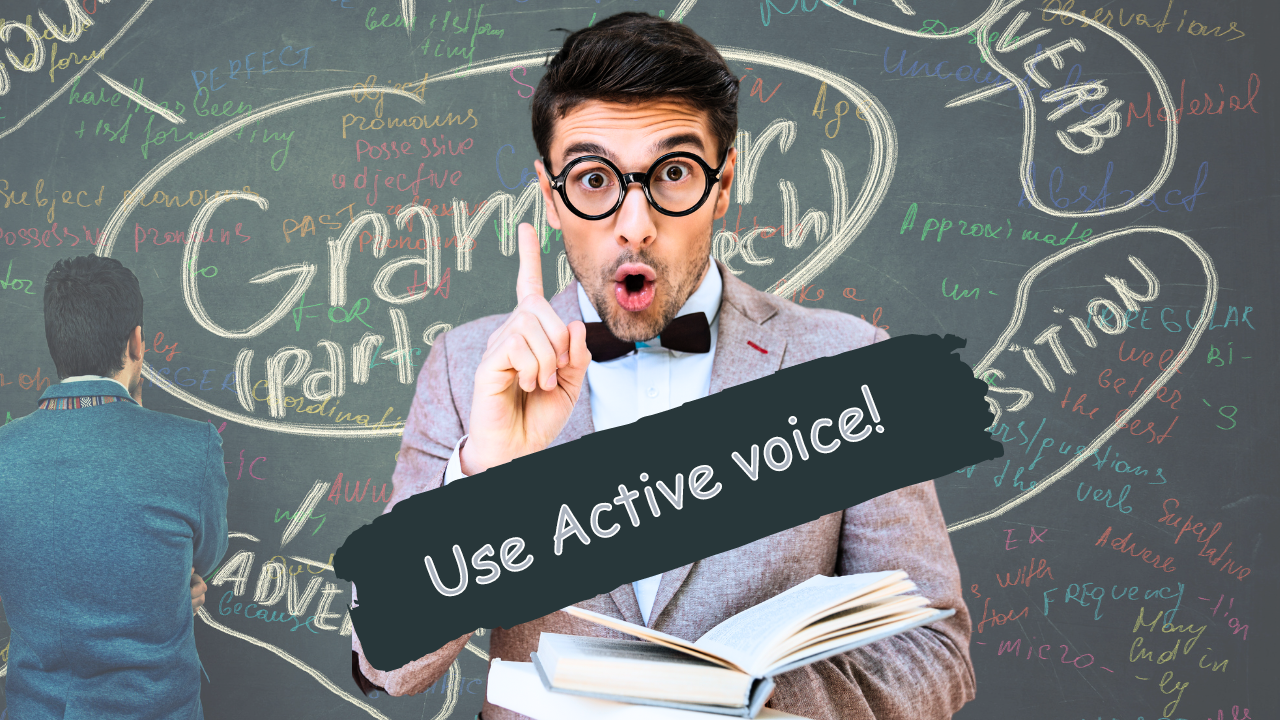SD #39 | Boost Your Storytelling With Active Voice
Apr 17, 2023
Nerd Alert! Boost Your Storytelling with Active Voice
(Trouble viewing images? Click view in web browser)
Read Time: 6.0 minutes
From advertisers and marketers to salespeople and leaders, everyone wants to hold their audience’s attention. They want to make ads, pitches, presentations, and content that captivates audiences and keeps them engaged. But not all content has that effect. What makes some content more engaging?
— Journal of Marketing | What Holds Attention?
What’s the Tip
Today's tip is to use the active voice in creating your content. Yep, that's right, active voice. How incredibly nerdy, right? If you're like us, the mere mention of active voice takes us back to 7th grade English class and diagramming sentences. Ugh.
But here's the inspiration behind today's tip. Several business school professors recently published a paper where they tackled the question: what holds attention? Shout out to Jelena Zoric who first shared this study on LinkedIn here.
To get a handle on this question, the professors studied what made people pay attention to content.
But they didn't study just a handful of content. There were 600,000 reading sessions from 35,000 pieces of content involved in the making of this study.
The study revealed that a key driver of attention is making things easy for the brain to process. In other words: keep it simple.
This brings us today's tip: the active voice, an often overlooked, if not completely forgotten, hack for making your content clear and engaging.
How Do You Use It?
Like anything else, don't force active voice into your content.
It's more about mindset and looking for spots where simply switching the construction of your sentence from passive to active voice can help your audience engage with your content.
Like a lot of things, it's about user or customer experience.
Look at these two sentences: Bob threw the ball (active voice) vs. The ball was thrown by Bob (passive voice).
With the active voice example, the subject is super clear and what the subject did is super clear, too. We've got a guy named Bob and we know he threw the ball.
In the passive voice example, we've got a ball but it takes two words to find out what happened to the ball (it was thrown) and it takes four words to find out who did it (our friend Bob).
Here's the thing: People scan your content. They don't read it. (This statement is written in active voice).
Here's the same statement above written in passive voice: Your content is scanned by people. Reading your content isn't what people do.
When you keep subjects and verbs close together, it's actually easier and faster for the brain to process what you're saying.
Point scored for your 7th grade composition teacher.
What are Some Examples?
Yes, there are some business cases to be made for the nerdy, grammatical concept of active voice. Here are some examples to spur your thinking.
Example 1:
Active voice: Our team designed a cutting-edge app to improve your productivity.
Passive voice: A cutting-edge app to improve your productivity was designed by our team.
***
Example 2:
Active voice: We offer 24/7 customer support to address your concerns immediately.
Passive voice: 24/7 customer support is offered to address your concerns immediately.
***
Example 3:
Active voice: Our innovative software saves you time and streamlines your workflow.
Passive voice: Time is saved and your workflow is streamlined by our innovative software.
***
In each example, the active voice is more powerful than the passive voice for the following reasons:
Clarity and emphasis: Active voice sentences clearly identify the subject and its role in performing the action. This provides a stronger focus on the business (e.g., "Our team" or "We") and the value they bring to the customers. In contrast, passive voice sentences place emphasis on the action or the object, making the subject less prominent.
Efficiency: Active voice sentences are generally shorter and more concise than passive voice sentences, as they use fewer words to convey the same message. This makes the content easier to read and comprehend.
Engagement and connection: Active voice creates a sense of immediacy and involvement, fostering a stronger connection between the business and its audience. By using active voice, the business appears more proactive, which can encourage potential customers to trust and engage with the company.
What's the Benefit to You?
Clarity, efficiency, and engagement are all key benefits of using active voice, and here's why:
- Your content is more likely to be understood by the audience, leading to better communication and more informed decision-making.
- It helps audiences quickly grasp information, saving time and reducing the likelihood of misunderstandings.
- Your content will get to the point faster making it more likely to persuade readers to take action.
So, the next time you write something...an email, a Tweet, a blogpost, anything...read it at least one time looking for opportunities to use active voice.
Your reader will thank you.
TL:DR
- 📚 Study: Researchers analyzed 600,000 reading sessions from 35,000 pieces of content to determine what holds attention.
- 🧠 Key finding: Making content easy for the brain to process (i.e., keeping it simple) is crucial for maintaining attention.
- 🎯 Active voice: Use active voice in your content to make it simpler and more engaging.
- 🔄 Switching: Look for opportunities to switch from passive to active voice without forcing it.
- 📈 Business examples: Active voice provides clarity, efficiency, and engagement, making it more powerful in professional communication.
- 🌟 Benefits: Clear and concise content improves communication, saves time, and increases the likelihood of persuading readers to take action.
- 🏆 7th-grade composition: The importance of active voice validates the teachings of many English teachers.
We hope you've found this issue of StoryDirect helpful! If you'd like to read more posts like this each week, check out the StoryDirectors' Club!

